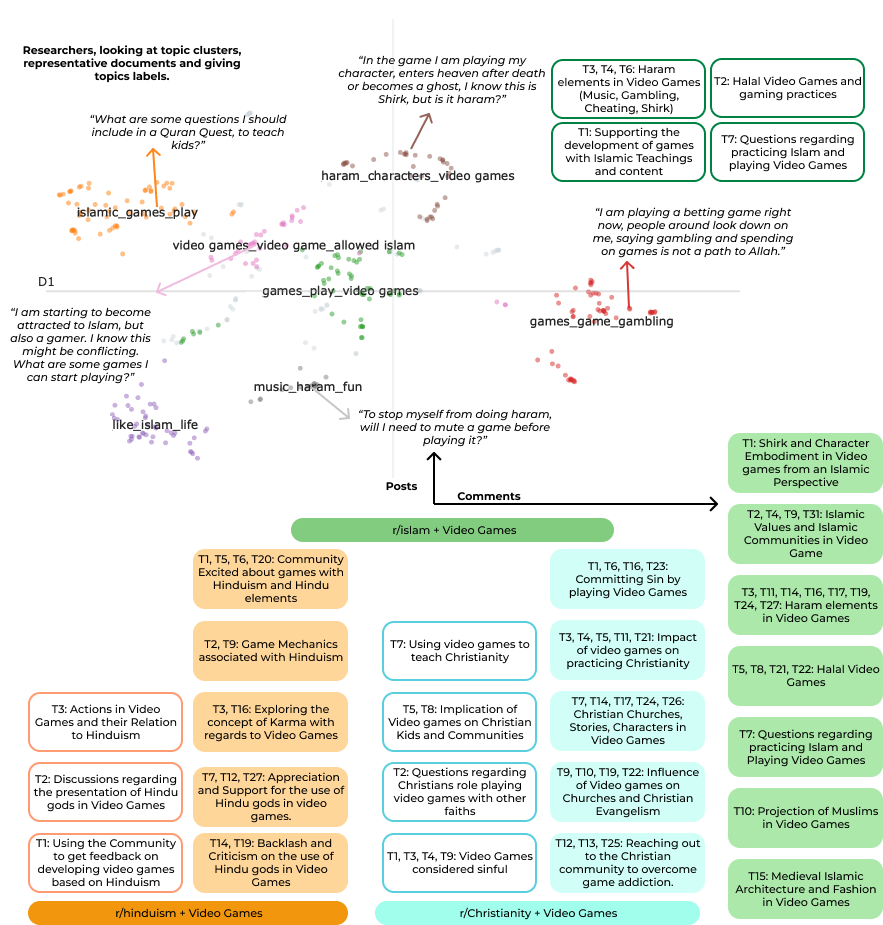Digital Discourse on Religion and Videogames
When SMITE included Hindu deities as playable characters, the game faced community backlash and legal complaints. When Christian players discovered prayer mechanics in The Binding of Isaac, they debated whether engaging with blasphemous content violated their faith. These incidents reveal a larger question: How do religious players actually perceive and discuss religious themes in videogames?
This case study documents a large-scale digital ethnography analyzing 10,000+ Reddit posts from religious and gaming communities. Using advanced topic modeling and qualitative analysis, I uncovered the complex ways players negotiate religious content in games—revealing tensions between creative expression, cultural sensitivity, and religious identity.
The Problem
Religious themes in games are growing, but developers lack understanding of player perceptions: Games increasingly draw from religious traditions for characters, narratives, and world-building. However, developers often design religious content without understanding how religious players—who represent billions of potential players—actually perceive these depictions. This blind spot risks cultural insensitivity, community backlash, and missed creative opportunities.
The gap: Game designers know some religious content provokes controversy, but they lack systematic understanding of what players find offensive versus engaging. When does incorporating religious themes feel like respectful cultural exploration, and when does it feel like appropriation or blasphemy? Without this understanding, developers either avoid religious content entirely or implement it without guidance.
The research opportunity: Religious players actively discuss these topics online—in gaming subreddits, religious forums, and community spaces. These conversations reveal authentic, unfiltered perspectives on how religious content is perceived, critiqued, and engaged with. Analyzing these digital discussions could provide the comprehensive understanding developers need.
My Approach
As Project Lead and Primary Researcher, I conducted a large-scale digital ethnography combining computational methods with qualitative analysis:
- Collected 10,000+ Reddit posts using Python's PRAW library, targeting both religious subreddits (r/Christianity, r/Islam, r/Hinduism) and gaming communities (r/pokemon, r/Smite)
- Applied advanced topic modeling (BERTopic) to automatically identify emerging themes across massive datasets—something traditional qualitative methods couldn't scale to
- Implemented human-in-the-loop validation: Researchers reviewed, interpreted, and labeled topic clusters to ensure contextual accuracy and nuance
- Conducted thematic analysis: Synthesized 22 sub-themes into 3 primary themes revealing the complex player-religion-game relationship
- Developed design guidelines: Translated research insights into actionable recommendations for game developers
Key Outcomes
- Identified 3 primary themes across 22 distinct sub-themes in player discussions
- Published at ACM CHI PLAY 2024—the premier games and HCI conference
- First large-scale digital ethnography on religion and videogames
- Created cultural sensitivity framework for game designers
- Mapped player perceptions: Blasphemous concerns vs. design opportunities vs. educational potential
- Developed actionable design guidelines for respectful religious representation
Research Methodology
Understanding how religious players perceive videogames required analyzing massive amounts of online discourse—far more than traditional qualitative methods could handle. I adopted a mixed-methods approach combining computational efficiency with human interpretation.

1. Data Collection: Scraping Reddit for Authentic Discourse
Reddit offered access to natural, unfiltered discussions about religion and games. I used Python's PRAW (Python Reddit API Wrapper) library to systematically collect posts and comments from:
- Religious communities: r/Christianity, r/Islam, r/Hinduism, r/Judaism
- Gaming communities: r/pokemon, r/Smite, r/gaming, r/truegaming
- Targeted keywords: Christian, Hindu, Islam, religious, faith, blasphemous, deity, prayer, etc.
The collection process: Over 10,000 posts were scraped, then meticulously cleaned to remove spam, off-topic content, and duplicate discussions. I focused on posts where religious themes directly intersected with specific games—not abstract religious discussions or game discussions unrelated to religion. This targeted approach ensured we analyzed actual player-perception data, not tangential conversations.
2. Topic Modeling with BERTopic: Scaling Up Analysis
Manually coding 10,000+ posts would be intractable. I used BERTopic—a state-of-the-art topic modeling tool that leverages sentence embeddings to automatically cluster text by semantic similarity.
Why BERTopic mattered: Unlike traditional topic models that rely on word frequency, BERTopic understands context. It recognizes that "game with gods" and "religious characters in videogames" belong to the same thematic cluster, even if they share few common words. This allowed automatic identification of meaningful themes across the massive dataset.
The output: BERTopic generated topic clusters for each subreddit, each containing semantically related posts. For example, in r/Islam, one cluster might contain discussions about prayer mechanics in games, while another focuses on concerns about blasphemous depictions.

3. Human-in-the-Loop Validation: Ensuring Contextual Accuracy
Computational models can identify patterns, but they can't interpret meaning, sarcasm, or cultural nuance. I implemented a human-in-the-loop process where researchers collaboratively reviewed each topic cluster generated by BERTopic.
The validation process: For each automated topic cluster, researchers (1) reviewed sample posts from the cluster, (2) interpreted the underlying theme, (3) assigned descriptive labels, and (4) flagged clusters that seemed semantically incoherent. This ensured that "topics" actually represented meaningful themes, not just statistical artifacts.
Why this hybrid approach worked: Computational efficiency handled the scale (10,000+ posts), while human interpretation ensured accuracy and nuance. We could process massive datasets without losing the qualitative depth that makes ethnography valuable.
Key Findings: Three Primary Themes
Through topic modeling and qualitative analysis, the research surfaced 22 distinct sub-themes, which synthesized into three primary themes revealing the complex, often contradictory relationship between religious players and videogames:
- Videogames Perceived as Blasphemous or Sinful: Players concerned about misrepresentation, trivialization, and conflicting values
- Religion as a Rich Design Space: Communities brainstorming ways to incorporate religious themes, narratives, and aesthetics
- Videogames for Religious Education and Community: Games explicitly designed or used to teach faith and foster community
Why these themes matter: They reveal the same players who critique games for blasphemy also champion religious content done respectfully. The same communities that protest misrepresentation also collaborate on incorporating religious themes. This complexity challenges simple "religion vs. games" narratives—the relationship is far more nuanced.

Theme 1: Blasphemous Elements & Misrepresentation
Many religious players felt games misrepresented or disrespected their beliefs. This wasn't abstract offense—it was concrete concern about how sacred figures, rituals, and values were depicted in gameplay contexts.
What players critiqued: Inaccurate depictions of deities, trivialization of sacred figures into combat stats, gameplay mechanics conflicting with religious values, and the act of "controlling" gods in games.

What this revealed: Players weren't rejecting religious content in games wholesale—they were critiquing specific practices: reducing deities to combat characters without context, depicting sacred figures in ways that contradicted their religious significance, and creating gameplay that trivialized deeply meaningful concepts. The concern wasn't about presence of religion, but about respectful representation.
Theme 2: Religion as a Rich Design Space
Despite concerns about blasphemy, many players enthusiastically view religion as a vast source of inspiration for game design. These same communities that protested misrepresentation actively brainstormed how to incorporate religious themes respectfully.
What players explored: Characters inspired by religious narratives, game mechanics grounded in sacred concepts, settings based on religious locations, and aesthetics drawn from religious art and architecture. Communities didn't reject religious content—they wanted it done well.
.png)
Why this matters: These discussions revealed player enthusiasm for culturally rich content and demonstrated that religious themes aren't taboo—they're desired when implemented respectfully. Players wanted their traditions represented, just not trivialized. This theme transforms the narrative from "religion vs. games" to "how can religion inspire better games?"
Theme 3: Videogames for Religious Education & Community
Beyond entertainment, religious communities actively leverage videogames for education and community building. Players develop or advocate for games that teach religious concepts, maintain faith, and connect communities.
How communities used games: Developing quiz games to teach religious knowledge, creating games around religious festivals and holidays, organizing community events in online games, and maintaining curated lists of "religiously appropriate" games for their communities.
.png)
The significance: This theme reveals that religious communities aren't just passive consumers or critics of games. They're actively participating in game creation, using games as pedagogical tools, and building social connections through gaming. Games aren't a threat to religious communities—they can be vehicles for faith expression and education when aligned with religious values.
Conclusion & Implications for Game Design
This research illuminates the intricate, often paradoxical, relationship between religion and videogames. The three themes reveal a complex landscape where the same communities that critique blasphemous depictions also champion respectful religious content. Where some players find offense, others find inspiration. This isn't contradiction—it's nuance that game designers need to understand.
The central finding: Religious players don't reject religious themes in games wholesale. They reject disrespectful representation, trivialization of sacred concepts, and misrepresentation of their beliefs. When religious content is handled with cultural sensitivity and respect, players actively engage with it, create around it, and use it for education and community building.
For UX professionals and game designers, this research highlights critical considerations:
Design Guidelines
- Prioritize cultural sensitivity: Don't just reference religious themes—deeply research them. Understand the symbolic meanings, historical contexts, and cultural significance. Avoid reducing sacred figures to combat stats without considering their religious importance.
- Engage with communities: Foster dialogue with religious players and communities during development, not after release. Early engagement prevents costly backlash and creates better products.
- Acknowledge diverse perspectives: What feels respectful to one religious community may offend another. There's no universal "safe" approach—understand the specific communities your game engages with.
- Leverage educational potential: Religious communities actively use games for education and community building. Consider opportunities to support these purposes while maintaining game quality.
- Recognize the opportunity: Religious themes aren't a liability to be avoided—they're a rich design space offering creative potential, engaged audiences, and opportunities for meaningful gameplay when done respectfully.
Ultimately: Creating resonant, inclusive gaming experiences involving religion requires a thoughtful balance between creative expression, community expectations, and profound respect for diverse beliefs. Games can explore religious themes, represent cultural traditions, and even engage sacred concepts—when designers approach these topics with the care, research, and community engagement that religious content deserves.
Skills & Methods Demonstrated
Research: Digital Ethnography • Mixed-Methods Research • Qualitative Analysis • Community Research
Technical: Python Programming • Web Scraping (PRAW) • Topic Modeling (BERTopic) • Data Analysis • NLP
Analysis: Thematic Analysis • Content Analysis • Human-in-the-Loop Validation • Pattern Recognition
Impact: Design Guidelines Development • Academic Publishing • Cross-Cultural Research • Ethical Research Practice